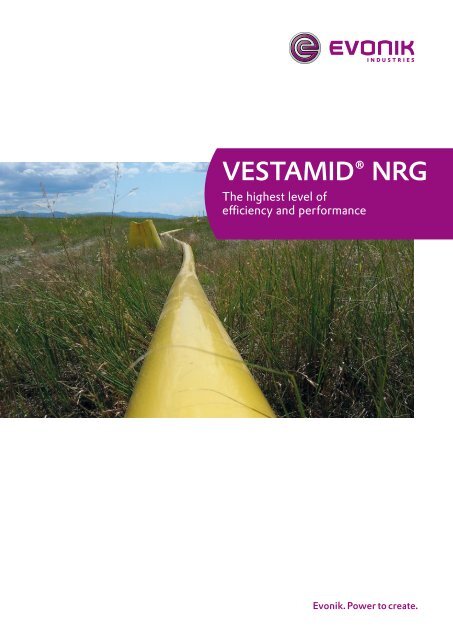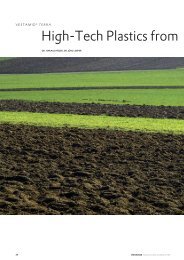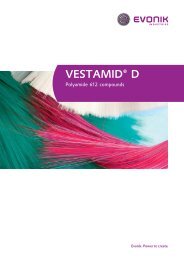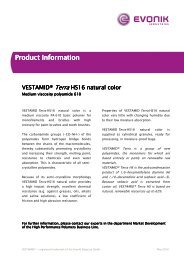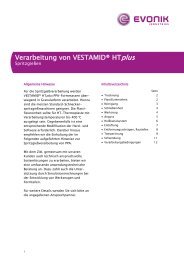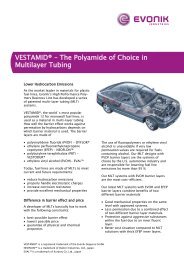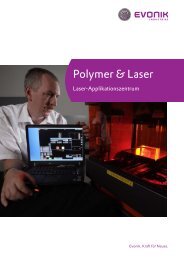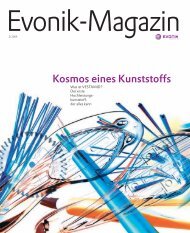VESTAMID® NRG for gas pipes and steel pipe protection
VESTAMID® NRG for gas pipes and steel pipe protection
VESTAMID® NRG for gas pipes and steel pipe protection
Create successful ePaper yourself
Turn your PDF publications into a flip-book with our unique Google optimized e-Paper software.
VESTAMID® <strong>NRG</strong><br />
The highest level of<br />
efficiency <strong>and</strong> per<strong>for</strong>mance
The bundle of energy<br />
High per<strong>for</strong>mance solutions<br />
<strong>for</strong> the energy market
Contents<br />
VESTAMID® <strong>NRG</strong><br />
Page<br />
4<br />
Gas <strong><strong>pipe</strong>s</strong><br />
VESTAMID® <strong>NRG</strong> –<br />
beyond what PE can offer<br />
Superior per<strong>for</strong>mance characteristics <strong>for</strong><br />
Intended applications – VESTAMID® <strong>NRG</strong><br />
Maximizing infrastructure assets<br />
<strong>and</strong> contributing to the bottom line<br />
Proven record of per<strong>for</strong>mance<br />
Page<br />
6<br />
Steel <strong>pipe</strong> <strong>protection</strong><br />
High-end application capabilities<br />
Page<br />
14<br />
Installation methods<br />
Horizontal directional drilling<br />
Soil displacement method with<br />
non-steered displacement hammers<br />
The plow method<br />
Dynamic ramming with non-steered<br />
ramming machines<br />
Pipe bursting<br />
Page<br />
18<br />
Frequently Asked Questions<br />
Page<br />
22
VESTAMID® <strong>NRG</strong><br />
The highest level of efficiency <strong>and</strong> per<strong>for</strong>mance<br />
About Evonik<br />
German-based Evonik Industries is one of the world<br />
leaders in specialty chemicals. The high per<strong>for</strong>mance<br />
polymers of Evonik are suitable <strong>for</strong> a virtually unlimited<br />
range of uses, including a particularly large number of<br />
applications in the energy sector. High per<strong>for</strong>mance<br />
polymers are used in flexible photovoltaic modules,<br />
wind power facilities, <strong>and</strong> in the oil <strong>and</strong> <strong>gas</strong> industry.<br />
Depending on the application, these polymers provide<br />
<strong>protection</strong> against corrosion or chemicals, increase the<br />
safety of energy transport, or enhance the efficiency<br />
of energy generation.<br />
More energy with VESTAMID® <strong>NRG</strong><br />
The polyamide 12 VESTAMID® <strong>NRG</strong> is specifically<br />
developed <strong>for</strong> energy efficient <strong>gas</strong> <strong>and</strong> oil <strong>pipe</strong>lines.<br />
VESTAMID® <strong>NRG</strong> contains the previously introduced<br />
<strong>and</strong> established products LX9020, LX9026, LX9030<br />
<strong>and</strong> LX9032 under the new name <strong>NRG</strong>.<br />
These polyamides have extraordinary resistance to<br />
mechanical stress, stress fracturing, <strong>and</strong> chemicals such<br />
as crude oil. Thanks to these properties, they can be<br />
used to protect the exterior <strong>and</strong> interior of onshore <strong>and</strong><br />
offshore oil <strong>and</strong> <strong>gas</strong> <strong>pipe</strong>lines.VESTAMID® <strong>NRG</strong> bundles<br />
energy by making the transport <strong>and</strong> extraction of fossil<br />
energy sources more efficient <strong>and</strong> by contributing to<br />
generating renewable energies.<br />
Further applications of polyamide 12<br />
The applications of polyamide 12 range from sophisticated<br />
line systems such as fuel lines, through core<br />
insulation in the cable industry <strong>and</strong> catheters in medical<br />
technology, to precision injection-molded parts like<br />
impellers <strong>and</strong> control-valve housings in machine <strong>and</strong><br />
equipment manufacture.<br />
4
General properties of polyamide 12<br />
• Minimal water absorption: Molded parts show<br />
almost no dimensional changes with variation in<br />
atmospheric humidity.<br />
• Extraordinarily high impact resistance <strong>and</strong><br />
Charpy notched impact strength, even well<br />
below freezing point<br />
• Good to excellent resistance to greases, oils, fuels,<br />
hydraulic fluids, <strong>and</strong> many solvents as well as to<br />
salt solutions <strong>and</strong> other chemicals<br />
• Excellent resistance to stress cracking, including<br />
<strong>for</strong> metal parts encapsulated by injection molding<br />
or embedded into the plastic<br />
• Excellent abrasion resistance<br />
• Low dry sliding friction coefficient as compared<br />
with <strong>steel</strong>, polybutylene terephthalate, polyacetal,<br />
<strong>and</strong> other materials<br />
• Noise <strong>and</strong> vibration damping properties<br />
• Excellent resistance to fatigue caused by frequent<br />
load change<br />
• Easy processability<br />
5
Gas <strong><strong>pipe</strong>s</strong><br />
VESTAMID® <strong>NRG</strong> 2101 yellow is a high molecular<br />
grade PA12 material developed by Evonik.<br />
Its superior per<strong>for</strong>mance characteristics make it an<br />
ideal choice <strong>for</strong> exp<strong>and</strong>ing the use of thermoplastic<br />
piping systems at higher operating pressure <strong>and</strong><br />
larger diameters to replace metallic piping systems<br />
in a safe <strong>and</strong> cost effective manner.<br />
VESTAMID® <strong>NRG</strong> 2101 yellow piping systems<br />
offer a 25 percent increase in the overall operating<br />
pressures as compared to the closest other high<br />
pressure plastic material.<br />
Besides extending the operating pressure limits of<br />
thermoplastic piping systems, VESTAMID® <strong>NRG</strong> 2101<br />
yellow offers many of the same benefits, <strong>and</strong> in most<br />
instances more superior per<strong>for</strong>mance, as conventional<br />
PE piping systems.<br />
• Tough <strong>and</strong> durable<br />
• Corrosion resistant<br />
• Resistant to heavy hydrocarbons<br />
• High resistance to Slow Crack Growth<br />
<strong>and</strong> Rapid Crack Propagation<br />
• Increased installation efficiencies<br />
• Worry free per<strong>for</strong>mance<br />
VESTAMID® <strong>NRG</strong> –<br />
beyond what PE can offer<br />
Realize long distances –<br />
coiled VESTAMID® <strong>NRG</strong> <strong><strong>pipe</strong>s</strong><br />
VESTAMID® <strong>NRG</strong> – Polyamide 12 (PA12)<br />
Polyamide 12 is a high per<strong>for</strong>mance thermoplastic<br />
polymer with increased per<strong>for</strong>mance characteristics<br />
that translates into safe operations over the life of<br />
the installed <strong>pipe</strong>line. It has a considerable record of<br />
safe <strong>and</strong> proven experience in many dem<strong>and</strong>ing<br />
applications, including fuel lines in passenger cars,<br />
air brake tubing in trucks, <strong>and</strong> off-shore applications.<br />
These characteristics make VESTAMID® <strong>NRG</strong> an ideal<br />
choice when selecting appropriate thermoplastic<br />
piping materials in extending your <strong>gas</strong> distribution<br />
infrastructure.<br />
VESTAMID® <strong>NRG</strong> 2101 yellow material complies with<br />
ASTM F2785, ISO 22621 <strong>and</strong> ISO 16486 specifications.<br />
A complete system exists to allow <strong>gas</strong> utility companies<br />
to take advantage of the numerous benefits of<br />
VESTAMID® <strong>NRG</strong> 2101 yellow piping systems at<br />
higher operating pressures.<br />
Read further to discover how VESTAMID® <strong>NRG</strong> can<br />
help your company maximize its capital budgets <strong>and</strong><br />
extend the benefits of plastic piping materials within<br />
your natural <strong>gas</strong> distribution infrastructure in a safe<br />
<strong>and</strong> reliable manner.<br />
6
A – Pipe <strong>and</strong> fittings data sheet<br />
Property Unit Test procedure<br />
VESTAMID®<br />
<strong>NRG</strong> 2101 yellow<br />
Material designation PPI TR-4 PA12<br />
Cell classification ASTM D3350 PA423<br />
Pipe properties<br />
Density at 73°F resp 23°C g/cm³ ISO 1183 1.02<br />
Hydrostatic design basis at 73°F (23°C) psi ASTM D2837 3,150<br />
Hydrostatic design basis at 140°F (60°C) psi ASTM D2837 2,000<br />
Minimum required strength MPa/psi ISO 9080 18/261<br />
Rapid Crack Propagation critical pressure (PC), 32°F (0°C) bar/psig ISO 13478 30/435<br />
Pipe test category ---- ASTM D2513<br />
Material properties<br />
Tensile strength at yield MPa/psi ASTM D638/ISO 527 39/5,760<br />
Elongation at break, Type I bar % ASTM D638/ISO 527 >200<br />
Flexural modulus MPa ISO 527 1,300<br />
PENT (2.4 MPa) h ASTM F1473 >2,000 hours<br />
PENT (4.8 MPa) 1 h ---- >2,000 hours<br />
Moisture absorption 74°F resp. 23°C/50% r.h. % ISO 62 0.8<br />
Water absorption (saturation) % ISO 62 1.5<br />
Thermal properties<br />
Melting range DSC 2 nd heating °C/°F ISO 11357 177/350<br />
Vicat softening temperature<br />
Method A 10N °C/°F ISO 306 176/349<br />
Method B 50N °C/°F ISO 306 150/302<br />
1<br />
Test specimen <strong>and</strong> overall test methodology is same as ASTM F1473 but at increased stress levels<br />
B – Physical data<br />
Material Properties St<strong>and</strong>ard Specimen Requirement Unit<br />
VESTAMID®<br />
<strong>NRG</strong> 2101<br />
yellow<br />
Melting point ISO 3146, ISO 11357 granules 170 -195 °C/°F 177/350<br />
Heat of fusion ISO 3146, ISO 11357 granules --- J/g 65<br />
Glass transition temperature ISO 3146, ISO 11357 granules --- °C/°F 36/97<br />
Heat capacity DSC ISO 3146, ISO 11357 granules --- J/(g•K) 2.02<br />
Thermal expansion coefficient ISO 11359 2“ SDR11 --- µm/(m•K) 144<br />
Thermal conductivity coefficient ASTM C177 --- W/(m•K) 0.25<br />
Softening point Vicat<br />
A (10N) ISO 306 derived from ISO 527/1A --- °C/°F 170/338<br />
Softening point Vicat<br />
B (50N) ISO 306 derived from ISO 527/1A --- °C/°F 150/302<br />
Heat distortion temperature<br />
(HDT A - 1,80 MPa) ASTM D648 derived from ISO 527/1A --- °C/°F 45/113<br />
Heat distortion temperature<br />
(HDT B - 0,45 MPa) ASTM D648 derived from ISO 527/1A --- °C/°F 145/293<br />
Longitudinal reversion ISO 2505 2“ SDR11 max. 3 % 0.33<br />
7
Gas <strong><strong>pipe</strong>s</strong><br />
Lightweight <strong>and</strong> flexible<br />
VESTAMID® <strong>NRG</strong> 2101 yellow piping systems are<br />
lightweight with a greater degree of flexibility as<br />
compared to <strong>steel</strong> or other metallic piping materials<br />
while retaining their toughness <strong>and</strong> durability.<br />
Advantage VESTAMID® <strong>NRG</strong>:<br />
coiling is not an issue<br />
The lightweight nature of VESTAMID® <strong>NRG</strong> 2101<br />
yellow piping systems reduces the overall transportation<br />
costs <strong>and</strong> make it easier <strong>for</strong> crews to work<br />
with it on the job site. The increased flexibility<br />
allows <strong>for</strong> piping systems to be transported in coils<br />
thereby reducing the number of joints or fittings<br />
<strong>and</strong> allow the use of innovation trenchless installation<br />
techniques such as planting <strong>and</strong> plowing.<br />
Superior per<strong>for</strong>mance characteristics<br />
<strong>for</strong> the intended application –<br />
VESTAMID® <strong>NRG</strong><br />
The key to building world class <strong>gas</strong> piping systems<br />
is using materials with superior per<strong>for</strong>mance characteristics<br />
<strong>and</strong> a proven track record of safety <strong>for</strong><br />
the intended application.<br />
VESTAMID® <strong>NRG</strong> exhibits the following key<br />
per<strong>for</strong>mance characteristics <strong>and</strong> benefits which<br />
makes it an ideal material <strong>for</strong> high pressure <strong>gas</strong><br />
distribution applications.<br />
The net effects are improved installation efficiency,<br />
reduction in overall installation costs, <strong>and</strong> an overall<br />
positive impact to the environment.<br />
Increased toughness <strong>and</strong> durability<br />
Extensive research data <strong>and</strong> actual field per<strong>for</strong>mance<br />
validate the overall toughness <strong>and</strong> durability of<br />
VESTAMID® <strong>NRG</strong> 2101 yellow. Experience has proven<br />
that VESTAMID® <strong>NRG</strong> 2101 yellow retains its toughness<br />
<strong>and</strong> durability over a wide range of installation<br />
conditions including higher temperatures, excessive<br />
bending strains, highly compressive <strong>and</strong>/or contaminated<br />
soils. Most importantly, the increased toughness<br />
<strong>and</strong> durability of VESTAMID® <strong>NRG</strong> 2101 yellow<br />
allows it, to withst<strong>and</strong> the potential impact of third<br />
party damage better than most thermo-plastic<br />
materials being used today.<br />
C – Longterm mechanical properties<br />
Material properties St<strong>and</strong>ard Specimen Unit<br />
VESTAMID®<br />
<strong>NRG</strong> 2101 yellow<br />
LPL ISO 9080 2“ SDR11 MPa 19.04<br />
MRS ISO 12162 2“ SDR11 MPa 18<br />
HDB 73°F ASTM D2813 2“ SDR11 psi 3,150<br />
HDB 140°F ASTM D2813 2“ SDR11 psi 2,000<br />
MOP (bar) = (MRS * 20) / (2 * (SDR-1)) MOP = Maximum Operating Pressure MRS = Minimum Required Strength<br />
MOP (psi) = ((HDB * 2) / (SDR – 1)) * 0,4 SDR = St<strong>and</strong>ard Dimension Ratio HDB = Hydrostatic Design Basis<br />
LPL = Lower Prediction Limit<br />
8
Increased long term strength<br />
Both ASTM <strong>and</strong> ISO have established protocols to<br />
characterize the long term strength of thermoplastic<br />
<strong><strong>pipe</strong>s</strong> used in <strong>gas</strong> distribution applications.<br />
As compared to other thermoplastic materials,<br />
VESTAMID® <strong>NRG</strong> 2101 yellow has a higher hydrostatic<br />
design basis (HDB) <strong>and</strong> a higher minimum required<br />
strength (MRS) that provides operators with greater<br />
flexibility in their overall design approach to satisfy<br />
capacity considerations. (Tab. C)<br />
With VESTAMID® <strong>NRG</strong> 2101 yellow piping systems,<br />
operators can make in<strong>for</strong>med decisions <strong>for</strong> the most<br />
effective outside diameter <strong>and</strong> wall thickness combinations<br />
to use. For a given design pressure, <strong>gas</strong><br />
utility companies can utilize thinner wall <strong>pipe</strong> sizes<br />
thereby increasing flow capacity <strong>and</strong> increasing<br />
savings in material costs. For a given SDR (ratio of the<br />
outside diameter to wall thickness), <strong>gas</strong> companies<br />
can significantly increase the operating pressure as<br />
compared to other thermoplastic materials.<br />
Increased design life<br />
Over 40 years of field experience with PE piping<br />
systems have demonstrated that one of the leading<br />
causes of field failures with plastic piping systems<br />
is due to Slow Crack Growth (SCG) as a result of<br />
various factors including: improper manufacturing<br />
or installation practices such as squeeze-off, excessive<br />
bending strain, poor fusion alignment, etc;<br />
<strong>and</strong> environmental factors such as rocky soils or<br />
point loads. (Tab. D)<br />
To ensure the safe use of plastic piping materials<br />
against the failures due to SCG, both ASTM <strong>and</strong> ISO<br />
st<strong>and</strong>ards have incorporated per<strong>for</strong>mance based<br />
requirements <strong>and</strong> tests including the Pennsylvania<br />
Notch Test (PENT Test) <strong>and</strong> Notch <strong>pipe</strong> Test.<br />
Evonik has per<strong>for</strong>med extensive testing of its<br />
VESTAMID® <strong>NRG</strong> 2101 yellow that validates the<br />
superior SCG resistance characteristics <strong>and</strong> ensures<br />
greater long term per<strong>for</strong>mance. Compared to other<br />
thermoplastic materials, VESTAMID® <strong>NRG</strong> 2101<br />
yellow per<strong>for</strong>ms extremely well under the PENT test.<br />
To illustrate, VESTAMID® <strong>NRG</strong> 2101 yellow did not<br />
fail even after 2,000 hours under the PENT test at<br />
a stress of 4.8 MPa which is two times greater than<br />
the current test requirements per ASTM F1473.<br />
Squeeze-off at joined<br />
VESTAMID® <strong>NRG</strong> <strong><strong>pipe</strong>s</strong><br />
D – Longterm mechanical properties<br />
Material properties St<strong>and</strong>ard Specimen Requirement Unit<br />
VESTAMID®<br />
<strong>NRG</strong><br />
SCG, GTI ISO 22621 / 13478 2“ SDR11 min. 500 h >2,000<br />
SCG, Gastec ISO 22621 / 13479 110 mm SDR11 min. 500 h > 810<br />
PENT test, GTI ASTM D2513 / F1743 Plaque min. 500 h >1,000<br />
Squeeze-off, GTI ASTM D2513 / ISO 22621 2“ SDR11 min. 500 h >1,000<br />
Rock impingment GTI Method / ISO 22621 2“ SDR11 min. 500 h >1,000<br />
Earth loading GTI Method / ISO 22621 2“ SDR11 min. 500 h >1,000<br />
Bending strain GTI Method / ISO 22621 2“ SDR11 min. 500 h >1,000<br />
9
Gas <strong><strong>pipe</strong>s</strong><br />
NO FAILURES<br />
NO PENT FAILURES at 4.8 MPa <strong>for</strong> over 2,000 hours<br />
NO FAILURES at 20 bar <strong>and</strong> 80°C (290 psig <strong>and</strong> 176°F)<br />
with a 20 percent NOTCH <strong>for</strong> over 1,000 hours<br />
NO FAILURES at 20 bar <strong>and</strong> 80°C (290 psig <strong>and</strong> 176°F)<br />
with a 30 percent NOTCH <strong>for</strong> over 1,000 hours<br />
NO FAILURES <strong>for</strong> 3/6 test specimens at 20 bar <strong>and</strong> 80°C<br />
(290 psig <strong>and</strong> 176°F) with a 50 percent NOTCH <strong>for</strong> over<br />
1,000 hours<br />
Besides the PENT test, the VESTAMID® <strong>NRG</strong><br />
2101 yellow also exhibits excellent resistance to<br />
surface scratches <strong>and</strong> notches. In comprehensive<br />
tests per ISO requirements, the VESTAMID® <strong>NRG</strong><br />
2101 yellow <strong>pipe</strong> materials did not fail after 1,000<br />
hours with a 30 percent notch using a test pressure<br />
of 20 bar at 80°C (290 psig at 176°F).<br />
Most importantly, the results of extensive testing<br />
has shown that the VESTAMID® <strong>NRG</strong> 2101 yellow<br />
has excellent resistance to persistent point loads<br />
resulting from a rock or other hard objects in the<br />
backfill material. In tests per<strong>for</strong>med at the Hessel<br />
Institute, the VESTAMID® <strong>NRG</strong> 2101 yellow<br />
material showed NO failures at 31 bar <strong>and</strong> 60°C<br />
(450 psig at 140°F) under the combined effects<br />
of internal pressure <strong>and</strong> point load. The results<br />
confirm the ability to safely use VESTAMID® <strong>NRG</strong><br />
2101 yellow without the need <strong>for</strong> additional backfill<br />
or s<strong>and</strong> bedding. (Tab. E)<br />
Cumulatively, the results show that the VESTAMID®<br />
<strong>NRG</strong> 2101 yellow material has ample strength <strong>and</strong><br />
toughness to resist failure due to slow crack growth<br />
under various types of in-service stresses leading to<br />
longer design lifetimes. (Tab. E)<br />
Excellent resistance to Rapid Crack Propagation<br />
The results of comprehensive testing have demonstrated<br />
that the VESTAMID® <strong>NRG</strong> 2101 yellow material<br />
has excellent resistance to failures from Rapid Crack<br />
Propagation (RCP).<br />
While actual RCP failures are rare, all materials<br />
are susceptible under the right set of conditions.<br />
To ensure only those materials with ample resistance<br />
to RCP failures are used <strong>for</strong> <strong>gas</strong> distribution applications,<br />
both ASTM <strong>and</strong> ISO st<strong>and</strong>ards require a series<br />
of tests including Small-Scale Steady State (S4 Test)<br />
<strong>and</strong> Full-Scale Test (FST). The FST test is considered<br />
to be the referee test.<br />
The results of Full-Scale RCP tests confirm the<br />
excellent RCP resistance of VESTAMID® <strong>NRG</strong> 2101<br />
yellow over the range of increased operating<br />
pressures.<br />
RCP results,<br />
Full scale Test in accordance to ISO 13477<br />
Pipe size<br />
P Critical at 0°C/32°F<br />
SDR 11 <strong>pipe</strong> 110 mm Pc,fs ≥ 30 bar/435 psig<br />
SDR 11 <strong>pipe</strong> 6-inch IPS Pc,fs ≥ 25 bar/362 psig<br />
Excellent chemical resistance<br />
A unique benefit of the inherent molecular make-up<br />
of the VESTAMID® PA12 material is that it has excellent<br />
chemical resistance to heavy hydrocarbons<br />
making it an ideal c<strong>and</strong>idate material <strong>for</strong> extremely<br />
harsh environmental conditions. As a result, the<br />
VESTAMID® PA12 material is an ideal choice where<br />
the soils have been contaminated due to <strong>gas</strong>oline spills,<br />
etc. (Tab. F)<br />
10
E – Longterm mechanical properties<br />
Secondary stress Test criterion Results<br />
Point load<br />
Test pressure = 31 bar/450 psig<br />
Hoop stress: 14.75 N/mm 2<br />
Test temperature = 60°C/140°F<br />
Test time >22,500 hours<br />
with no failures<br />
Point load<br />
Test pressure = 31 bar/450 psig<br />
Hoop stress: 10 N/mm 2<br />
Test temperature = 80°C/140°F<br />
3 mm inside notch Crack growth after 10,939 hours<br />
Rock imingement<br />
Earth loading<br />
Bending strain<br />
1,3 cm/0,5“ Indentation<br />
Test pressure = 20 bar/290 psig<br />
Test temperature = 80°C/176°F<br />
5% deflection of outside diameter<br />
Test pressure = 20 bar/290 psig<br />
Test pemperature = 80°C/176°F<br />
20 times OD<br />
Test pressure = 20 bar/290 psig<br />
Test temperature = 80°C/176°F<br />
Test time >1,000 hours<br />
with no failures<br />
Test time >1,000 hours<br />
with no failures<br />
Test time >1,000 hours<br />
with no failures<br />
F – Chemical resistance<br />
Change in weight (%)<br />
Change in tensile<br />
strength at yield (%)<br />
Material properties St<strong>and</strong>ard Specimen Requirements Results Requirements Results<br />
Control ASTM D2513-06 split ring --- --- --- ---<br />
Mineral oil ASTM D2513-06 split ring
Gas <strong><strong>pipe</strong>s</strong><br />
Proven methods of Joining<br />
The overall integrity <strong>and</strong> longevity of any piping<br />
system is predicated on its weakest link. In the case<br />
of metallic piping systems, this has been joints where<br />
mechanical fittings or <strong>gas</strong>kets are used that tend to<br />
corrode of leak over the lifetime of the <strong>pipe</strong>line.<br />
Joining of <strong>gas</strong> <strong><strong>pipe</strong>s</strong><br />
with heat fusion<br />
VESTAMID® <strong>NRG</strong> 2101 yellow piping systems can be<br />
constructed using proven butt heat fusion or electrofusion<br />
joining methods. It has been proven that joints<br />
made using either of these two methods are stronger<br />
than the actual <strong>pipe</strong> enhancing the overall integrity of<br />
the <strong>pipe</strong>line. The use of these methods do not require<br />
additional capital investment since conventional tools<br />
used with PE piping systems can be readily used. That<br />
is, there is no need <strong>for</strong> special butt fusion equipment or<br />
electro-fusion boxes when joining VESTAMID® <strong>NRG</strong><br />
2101 yellow <strong>pipe</strong> segments. This allows <strong>for</strong> the seamless<br />
<strong>and</strong> transparent integration within <strong>gas</strong> utility<br />
companies’ operations.<br />
Maximizing infrastructure assets<br />
<strong>and</strong> contributing to the bottom line<br />
Given its superior per<strong>for</strong>mance characteristics, the<br />
VESTAMID® PA12 piping systems offer significant<br />
economic benefit as compared to other types of<br />
piping systems available in the marketplace.<br />
Flexible design alternatives<br />
A key advantage of the enhanced per<strong>for</strong>mance<br />
characteristics of the VESTAMID® <strong>NRG</strong> 2101 yellow<br />
material is it enables <strong>gas</strong> utility companies to implement<br />
flexible design scenarios to satisfy their capacity<br />
considerations <strong>and</strong> extending service to areas that<br />
were previously cost prohibitive.<br />
With the highest MRS <strong>and</strong> HDB rating of any other<br />
approved thermoplastic material, VESTAMID® <strong>NRG</strong><br />
2101 yellow can safely operate at pressure equal<br />
to or greater than 18 bar (250 psig). Alternatively,<br />
<strong>for</strong> a given line pressure, <strong>gas</strong> utility companies can<br />
choose to reduce the wall thickness <strong>and</strong> gain the<br />
additional necessary capacity to satisfy the critical<br />
dem<strong>and</strong> loads during the cold winter months.<br />
Joining of <strong>gas</strong> <strong><strong>pipe</strong>s</strong><br />
with electrofusion<br />
Availability of an overall complete system<br />
Evonik has partnered with leading <strong>gas</strong> component<br />
manufacturers to offer a complete line of <strong>pipe</strong> <strong>and</strong><br />
fittings con<strong>for</strong>ming to the strictest ASTM <strong>and</strong> ISO<br />
product specifications. This enables <strong>gas</strong> utility companies<br />
to effectively design, construct, <strong>and</strong> maintain<br />
VESTAMID® <strong>NRG</strong> 2101 yellow piping systems capable<br />
of lasting a long time with worry free service.<br />
Transition fittings <strong>and</strong> risers con<strong>for</strong>ming to ASTM<br />
F1973 are available to “tie-in” into existing <strong>steel</strong> assets.<br />
Electrofusion couplings <strong>and</strong> saddles per ASTM F2767<br />
are also available to connect the PA12 piping segments<br />
<strong>and</strong> extend lateral connections.<br />
G – Butt fusion joints<br />
Material properties St<strong>and</strong>ard Specimen<br />
Ambient<br />
temperature<br />
at fusion Requirement Unit<br />
VESTAMID®<br />
<strong>NRG</strong> 2101<br />
yellow<br />
Hydrostatic strength ISO 22621 / 1167 110 mm SDR11 0°C/ 32°F min. 165 h >165<br />
Hydrostatic strength ISO 22621 / 1167 110 mm SDR11 23°C/ 73°F min. 165 h >165<br />
Hydrostatic strength ISO 22621 / 1167 110 mm SDR11 40°C/104°F min. 165 h >165<br />
12
Reduced life cycle costs<br />
Like PE, the VESTAMID® <strong>NRG</strong> 2101 yellow piping<br />
systems offer superior range of economic benefits <strong>for</strong><br />
<strong>gas</strong> utility companies as compared to metallic piping.<br />
Connection to <strong>steel</strong> <strong>pipe</strong>line<br />
with transition fittings<br />
• The VESTAMID® <strong>NRG</strong> <strong>pipe</strong> is lightweight <strong>and</strong><br />
easier to h<strong>and</strong>le <strong>and</strong> transport<br />
• The VESTAMID® <strong>NRG</strong> piping systems eliminate<br />
the need <strong>for</strong> long term corrosion control measures<br />
• Given its inherent flexibility, the VESTAMID® <strong>NRG</strong><br />
<strong><strong>pipe</strong>s</strong> can be provided in coils thereby reducing the<br />
number of joints that must be per<strong>for</strong>med in the field<br />
resulting in increased productivity <strong>and</strong> reduced<br />
installation costs<br />
• Together with the <strong>pipe</strong> coils, the use of planting/<br />
plowing installation techniques can be used to<br />
install more <strong>pipe</strong> over a shorter period of time as<br />
compared to other methods of installation<br />
• Depending on the application <strong>and</strong> capacity considerations,<br />
the VESTAMID® <strong>NRG</strong> piping systems<br />
can be utilized with thinner wall applications <strong>and</strong><br />
thereby further reducing material costs <strong>and</strong> maximizing<br />
capacity<br />
• The VESTAMID® <strong>NRG</strong> <strong><strong>pipe</strong>s</strong> can be utilized with<br />
an array of low-cost trenchless rehabilitation<br />
techniques including horizontal directional drilling,<br />
sliplining, <strong>pipe</strong> bursting, etc.<br />
• VESTAMID® <strong>NRG</strong> 2101 yellow retains its chemical,<br />
physical, <strong>and</strong> mechanical stability over its design<br />
life <strong>and</strong> does not experience premature oxidative<br />
degradation, circumferential expansion, or loss of<br />
long term strength over its design life.<br />
Proven record of per<strong>for</strong>mance<br />
The VESTAMID® <strong>NRG</strong> 2101 yellow piping systems<br />
have been extensively tested under actual field<br />
settings over the range of <strong>pipe</strong> sizes, intended<br />
operating pressures, <strong>and</strong> installation environments.<br />
The results provide unequivocal proof that the<br />
VESTAMID® <strong>NRG</strong> 2101 yellow piping systems<br />
provide a valuable alternative to metallic piping <strong>and</strong><br />
peace of mind.<br />
In general, VESTAMID® <strong>NRG</strong> 2101 yellow piping<br />
systems offer <strong>gas</strong> utility companies with flexible<br />
design scenarios to replace metallic piping systems or<br />
to extend the use of thermoplastic piping systems at<br />
higher operating pressures in a safe, reliable, <strong>and</strong> cost<br />
effective manner.<br />
Coiled <strong><strong>pipe</strong>s</strong><br />
<strong>and</strong> heat fusion<br />
13
Steel <strong>pipe</strong> <strong>protection</strong><br />
High-end application capabilities<br />
VESTAMID® <strong>NRG</strong> offers a flexible, mechanically<br />
tough casement system that combines the advantages<br />
of polyethylene coating <strong>and</strong> cement mortar<br />
casing.<br />
Advantages of VESTAMID® <strong>NRG</strong><br />
as encasement material<br />
• Unusually high impact resistance <strong>and</strong> toughness,<br />
even at low temperatures<br />
• Excellent stress cracking resistance<br />
• Excellent wear resistance<br />
• Low sliding friction coefficient<br />
Product characteristics compared with other<br />
encasement materials<br />
VESTAMID® <strong>NRG</strong> has higher Shore hardness than<br />
polyethylene or polypropylene. In contrast to polyethylene<br />
or propylene encasement, there<strong>for</strong>e, the<br />
polyamide encasement offers both the corrosion<br />
<strong>protection</strong> provided by the barrier effect <strong>and</strong> mechanical<br />
<strong>protection</strong> <strong>for</strong> the encased <strong>steel</strong> <strong>pipe</strong>.<br />
Application areas <strong>for</strong> the new encasement material are<br />
found in non-conventional installation technologies<br />
such as:<br />
• Horizontal directional drilling<br />
• The soil displacement method with<br />
non-steered displacement hammers<br />
• Dynamic ramming<br />
• Plow technology<br />
14
H – VESTAMID® <strong>NRG</strong> 4101 yellow <strong>and</strong> <strong>NRG</strong> 4901 black <strong>for</strong> high per<strong>for</strong>mance <strong>steel</strong> <strong>pipe</strong> <strong>protection</strong><br />
Material properties Unit Test method Typical value<br />
Density at 73°F resp. 23 °C g/cm 3 ISO 1183 1.02<br />
Tensile strength at yield<br />
MPa<br />
psi ASTM D638 / ISO 527<br />
39<br />
5,760<br />
Elongation at break % ASTM D638 / ISO 527 >200<br />
Flexural modulus MPa ISO 527 1,300<br />
Moisture absorption at 73°F resp. 23°C/50% r.h. % ISO 62 0.8<br />
Water absorption (saturation) % ISO 62 1.5<br />
Thermal properties<br />
Melting range<br />
DSC 2 nd heating<br />
°F<br />
°C ISO 11357<br />
350<br />
177<br />
Method A<br />
10N<br />
°F<br />
°C ISO 306<br />
349<br />
176<br />
Vicat softening<br />
temperature<br />
Method B<br />
50N<br />
°F<br />
°C ISO 306<br />
302<br />
150<br />
VESTAMID® <strong>NRG</strong> <strong>protection</strong>:<br />
Realize long distances with plowing<br />
VESTAMID® <strong>NRG</strong> <strong>protection</strong>:<br />
Realize non-disruptive crossings<br />
under streets, rivers, channels<br />
with HDD<br />
15
Steel <strong>pipe</strong> <strong>protection</strong><br />
VESTAMID® <strong>NRG</strong> is applied on the <strong>steel</strong>-<strong>pipe</strong><br />
surface by established extrusion methods used <strong>for</strong><br />
PE or PP applications. Preliminary tests <strong>and</strong> pilot<br />
projects have yielded impressive evidence of the<br />
per<strong>for</strong>mance of VESTAMID® <strong>NRG</strong>. It was already<br />
clear in the preliminary tests that, due to its greater<br />
hardness, VESTAMID® <strong>NRG</strong> encasement showed as<br />
expected hardly any scoring, while of polypropylene<br />
encasement <strong>pipe</strong> insertion leaves clear tracks.<br />
In trenchless installation it must be ensured that<br />
the coating of the <strong>steel</strong> <strong>pipe</strong> is not damaged. Using<br />
the cathodic corrosion <strong>protection</strong> method, it was<br />
successfully demonstrated in the pilot projects that<br />
the PA12 coverings were not in any way damaged<br />
during the installation process.<br />
An initial pilot project <strong>for</strong> HDD installation was<br />
carried out in Algermissen, (Germany). For E.ON<br />
Avacon, a 300 m run of <strong>pipe</strong> was laid under a canal.<br />
No relevant damage to the VESTAMID® <strong>NRG</strong> layer<br />
was detected, either visually at the <strong>pipe</strong> section in<br />
the directional drilling borehole or by cathodic<br />
corrosion <strong>protection</strong> measurements.<br />
In a further pilot project, the plow method was used<br />
over a 1.5 km run near Wallersdorf (Germany), on<br />
a commission from Wasserversorgung Bayrischer<br />
Wald (WBW).<br />
Another example of applications of this type in<br />
offshore technology is reeling. The <strong><strong>pipe</strong>s</strong> are welded<br />
onshore into a kilometer-long run, spooled onto<br />
large <strong>pipe</strong> reels, <strong>and</strong> later laid as a run on the high<br />
seas. In this installation technology, the <strong>steel</strong> tubes<br />
even show plastic de<strong>for</strong>mation, a stress that the<br />
corrosion <strong>protection</strong> layer must also be capable of<br />
withst<strong>and</strong>ing.<br />
16
Notched impact strength<br />
in accordance with DIN ISO 179-1/1eA<br />
60<br />
50<br />
40<br />
30<br />
20<br />
A comparison of notched impact<br />
strengths demonstrates the excellent<br />
properties of VESTAMID® <strong>NRG</strong> against<br />
those of polypropylene, especially at<br />
low temperatures.<br />
10<br />
0<br />
-50 -40 -30 -20 -10 0 10 20 [°C]<br />
-58 -40 -22 -4 14 32 50 68 [°F]<br />
Temperature<br />
VESTAMID® <strong>NRG</strong> PP<br />
Tensile testing in accordance with DIN ISO 527<br />
80<br />
70<br />
60<br />
The fact that this material is harder<br />
also shows in the strength values it<br />
achieves, such as stress at yield.<br />
Polypropylene, which is stronger<br />
than polyethylene, can only be used<br />
at temperatures to 0°C/32°F.<br />
Tensile strength at yield [MPa]<br />
50<br />
40<br />
30<br />
20<br />
10<br />
0<br />
-50 -40 -30 -20 -10 0 10 20 [°C]<br />
-58 -40 -22 -4 14 32 50 68 [°F]<br />
Temperature<br />
VESTAMID® <strong>NRG</strong> PP HDPE<br />
Shore D hardness in accordance with DIN EN ISO 868<br />
80<br />
70<br />
VESTAMID® <strong>NRG</strong> offers a greater<br />
degree of Shore hardness than<br />
polyethylene <strong>and</strong> polypropylene.<br />
Shore hardness D (room temperature)<br />
60<br />
50<br />
40<br />
30<br />
20<br />
10<br />
0<br />
LDPE HDPE PP VESTAMID® <strong>NRG</strong><br />
17
Installation methods<br />
Horizontal directional drilling<br />
Horizontal directional drilling<br />
Horizontal directional drilling<br />
Directional drilling has seen an enormous boom<br />
in recent years. Directional drilling operations that<br />
would have appeared inconceivable just a few years<br />
ago are now routinely per<strong>for</strong>med at installation sites.<br />
Drilling is often carried out underneath <strong>and</strong> across rivers<br />
<strong>and</strong> other water bodies, <strong>and</strong> directional technology<br />
even allows drilling below industrial complexes. The<br />
application spectrum extends over all <strong>pipe</strong>work <strong>for</strong> the<br />
supply of <strong>gas</strong>, district heating, <strong>and</strong> drinking water, <strong>and</strong><br />
the installation of pressure lines <strong>for</strong> sewers.<br />
The installation technique is extremely eco-friendly,<br />
causing minimal ecological damage that is restricted<br />
to points in the immediate vicinity of the system.<br />
Many factors favor the use of directional technology<br />
even in urban areas: The technique scores over<br />
open-trench methods in terms of construction times<br />
<strong>and</strong> costs, licensing procedures, soil displacement,<br />
surface restoration, <strong>and</strong> traffic disruption.<br />
Advantages of the method<br />
• No opening up of useful surfaces, no surface<br />
damage (to road surfacing, front gardens, etc.),<br />
<strong>and</strong> no restoration required; there<strong>for</strong>e strong<br />
economic advantages<br />
• Low social costs by avoidance of diversions,<br />
closures of traffic lanes, setting up of signaling<br />
systems, etc.<br />
• Short setup times, short installation <strong>and</strong><br />
construction times<br />
• Particularly cost-effective <strong>for</strong> river crossings<br />
• Measurement of pulling <strong>for</strong>ce <strong>and</strong> determination<br />
of position are possible<br />
• Broad application spectrum<br />
HDD with<br />
VESTAMID® <strong>NRG</strong> <strong>gas</strong> <strong><strong>pipe</strong>s</strong><br />
The combination of fluid-assisted drilling with<br />
impact support allows propulsion <strong>and</strong> steerability in<br />
difficult soils (with large-particle components, fairly<br />
large rock inclusions, or building-rubble deposits) of<br />
soil class 5, <strong>and</strong> in some cases up to soil class 6.<br />
The stringent requirements <strong>and</strong> expectations <strong>for</strong> the<br />
tasks to be accomplished dem<strong>and</strong> precise location <strong>and</strong><br />
steering of the drilling. For insertion of plastic <strong><strong>pipe</strong>s</strong><br />
(particularly those carrying <strong>gas</strong> <strong>and</strong> drinking water)<br />
the pulling <strong>for</strong>ces must not exceed the values specified<br />
in GW 321, 322, <strong>and</strong> 323. Horizontal directional<br />
drilling is described in GW 304 (Pipe Driving) <strong>and</strong><br />
ATV-A 125 <strong>and</strong> the relevant regulations.<br />
18
Soil displacement method with non-steered displacement hammers<br />
Soil displacement method with non-steered displacement hammers<br />
Soil displacement method with<br />
non-steered displacement hammers<br />
The plow method<br />
The soil displacement method has been established<br />
<strong>for</strong> three decades as a technique <strong>for</strong> underground<br />
<strong>pipe</strong> installation. A pneumatically operated displacement<br />
hammer creates an underground cavity into<br />
which are inserted short or long plastic or metal<br />
<strong><strong>pipe</strong>s</strong> up to DN 200, preferably without socket ends.<br />
The <strong><strong>pipe</strong>s</strong> are introduced in lengths of up to 40 m,<br />
depending on the soil, either simultaneously or in a<br />
second work step.This technique allows trenchless<br />
crossing of traffic routes, house service connections,<br />
preparation of anchoring, bypassing of obstacles,<br />
<strong>and</strong> other measures.<br />
The 2-stroke method<br />
Depending on the soil, the soil displacement hammers<br />
attain a ramming speed of up to 15 m/h. The<br />
soil displacement method is described in ATV-A 125<br />
<strong>and</strong> GW 304 (Pipe Driving), <strong>and</strong> other relevant<br />
regulations.<br />
Plowing technology has been very successfully used<br />
since the 1970s <strong>for</strong> laying of power <strong>and</strong> phone lines.<br />
It is particularly suitable <strong>for</strong> large, open, cross-country<br />
stretches where long line lengths are necessary;<br />
however, plowing can also be used over shorter<br />
distances <strong>and</strong> <strong>for</strong> lines in less readily accessible areas.<br />
Installation of these lines in sloping ground <strong>and</strong> the<br />
crossing of water bodies (with water levels of up to<br />
1.20 m) present no technical problems, thanks to the<br />
plow design with its four booms adjustable in any<br />
direction.<br />
This method is particularly suitable <strong>for</strong> soil types that<br />
are easily displaced, but even large-particle soils with<br />
a high proportion of stone present no problems.<br />
Advantages of the method<br />
• Financial savings of up to 50 percent<br />
• High daily capacity of up to 5,000 m possible<br />
• Short setup <strong>and</strong> construction times<br />
• Low HR costs<br />
• Fuel consumption reduced 90 percent<br />
• Plowing <strong>and</strong> line installation in a single operation<br />
• No groundwater lowering required<br />
• Minimal traffic disruption<br />
• Small working area<br />
• No topsoil removal<br />
• Low soil compaction<br />
• High installation quality<br />
Plowing with<br />
VESTAMID® <strong>NRG</strong> protected<br />
<strong>steel</strong> <strong><strong>pipe</strong>s</strong><br />
Source:<br />
www.tracto-technik.com<br />
19
Installation methods<br />
1. Ramming 2. Soil removal<br />
Dynamic ramming with non-steered ramming machines<br />
Dynamic ramming with non-steered ramming machines<br />
Dynamic ramming with<br />
non-steered ramming machines<br />
Dynamic <strong>pipe</strong> driving by the ramming method uses<br />
pneumatically operated <strong>pipe</strong>-driving machines. These<br />
allow installation of open <strong>steel</strong> <strong><strong>pipe</strong>s</strong> as casing or product<br />
<strong><strong>pipe</strong>s</strong> up to 4,000 mm in diameter over lengths of up<br />
to 80 m in soil classes 1-5 (<strong>and</strong> in some cases also in<br />
soil class 6, easily detachable rock) particularly cost<br />
effectively <strong>and</strong> without jacking abutments, under railroad<br />
lines, expressways, <strong>and</strong> rivers.<br />
Individual <strong>pipe</strong> lengths are pushed <strong>for</strong>ward in succession<br />
after welding. Due to the robust one-piece construction,<br />
a large ram at full capacity can generate an impact<br />
energy of 40,000 Nm, optimally transferred over the<br />
entire <strong>pipe</strong> string to the front cutting edge. The average<br />
ramming speed is 10 m/h.<br />
Advantages of the method<br />
• Little opening up of useful surfaces, low surface<br />
damage (to road surfacing, front gardens, etc.), <strong>and</strong><br />
little restoration, there<strong>for</strong>e strong cost advantages<br />
• Low social costs by avoidance of diversions,<br />
closures of traffic lanes, setting up of signaling<br />
systems, etc.<br />
• Short setup times, short installation times<br />
• The soil core remains in the <strong>pipe</strong> during ramming,<br />
so there is no water penetration when rivers are<br />
crossed.<br />
• Minimal cover, i.e., no large-scale trenches<br />
• Broad application spectrum<br />
The ramming technique is described in ATV-A 125<br />
<strong>and</strong> GW 304 (Pipe Driving) <strong>and</strong> the relevant<br />
regulations.<br />
20
Pipe bursting<br />
© Tracto-Technik . www.tracto-technik.de<br />
Pipe bursting<br />
Pipe bursting<br />
The <strong>pipe</strong> bursting method is an approved technique<br />
which is applicable according to the latest generally<br />
accepted technical st<strong>and</strong>ards.<br />
A <strong>pipe</strong> bursting machine is pulled through the old<br />
defective <strong>pipe</strong>. Its dynamic impact energy bursts<br />
the old <strong>pipe</strong> <strong>and</strong> displaces the fragments into the<br />
surrounding soil. A new <strong>pipe</strong>, of equal or larger<br />
diameter, is pulled in simultaneously. The old bore<br />
course must be usable <strong>for</strong> the new <strong>pipe</strong>line. Lateral<br />
inlets or bends have to be opened <strong>for</strong> a safe, tight <strong>and</strong><br />
professional connection. The soil surrounding the old<br />
<strong>pipe</strong> must be displaceable, the distance to existing<br />
<strong>pipe</strong>lines should be >0,5 m.<br />
The old <strong>pipe</strong> can be made of clay, cast iron, asbestos<br />
cement, plastic or unrein<strong>for</strong>ced concrete. Pipelines<br />
requiring replacement usually have longitudinal<br />
cracks, are leaky, are offset, have missing <strong>pipe</strong> pieces,<br />
no <strong>pipe</strong> bedding or have partially or completely<br />
collapsed. With burstlining it is not always necessary<br />
to carry out internal high pressure cleaning or remove<br />
any of the old <strong>pipe</strong>line. Damaged inliners can be<br />
replaced by new <strong><strong>pipe</strong>s</strong> with the burstlining method by<br />
using a special bladed cutting head.<br />
The machine bursts the damaged <strong>pipe</strong>line <strong>and</strong> pushes<br />
the fragments into the surrounding soil. Simultaneously<br />
the bore profile <strong>for</strong> the new <strong>pipe</strong> is exp<strong>and</strong>ed. The<br />
machine is pulled by a winch, which ensures line <strong>and</strong><br />
level is maintained through the existing bore path.<br />
The ground around the old <strong>pipe</strong> is usually easily<br />
penetrated. There are virtually no upsizing limitations.<br />
The ground plasticity allows, if necessary, the new<br />
<strong>pipe</strong> carrying capacity to be increased by up to two<br />
nominal sizes. Groundwater lowering is only necessary<br />
in the starting <strong>and</strong> exit pits.<br />
The annulus around the new <strong>pipe</strong> can be filled by<br />
using a bentonite/cement-mortar mix during the<br />
boring procedure. A mortar collar is <strong>for</strong>med around<br />
the new <strong>pipe</strong> giving full surfaced adhesion <strong>and</strong> <strong>pipe</strong><br />
support to the surrounding soil.<br />
PA12 <strong><strong>pipe</strong>s</strong> are especially recommended <strong>for</strong> this procedure.<br />
These <strong><strong>pipe</strong>s</strong> are highly resistant, sufficiently<br />
flexible <strong>and</strong> easily adapt to align with the old <strong>pipe</strong>line.<br />
Exp<strong>and</strong>ing up to two nominal sizes <strong>and</strong> strengthening<br />
of the <strong>pipe</strong> wall is possible.<br />
Advantages of the method<br />
• Environmentally friendly,<br />
trenchless <strong>pipe</strong> installations<br />
• Applicable <strong>for</strong> all types of damaged <strong><strong>pipe</strong>s</strong><br />
• Increased capacity by one or two nominal<br />
<strong>pipe</strong> sizes is possible<br />
• Long <strong>pipe</strong> lengths without joint sockets,<br />
pressure <strong><strong>pipe</strong>s</strong> can be replaced, too<br />
• Improvement of the bedding conditions<br />
by filling the <strong>pipe</strong> annulus<br />
• Innovative, quick - avoids unwanted social costs<br />
• Safe in accordance to technical regulations<br />
• Easy price saving calculations in advance<br />
• Long life GUARANTEE <strong>for</strong> new <strong><strong>pipe</strong>s</strong><br />
• SIMPLE - SAFE - EFFECTIVE<br />
Burst lining with<br />
VESTAMID® <strong>NRG</strong> <strong>gas</strong> <strong><strong>pipe</strong>s</strong><br />
Source:<br />
www.tracto-technik.com<br />
21
Frequently Asked Questions<br />
What are the moisture absorption<br />
characteristics of the PA12 materials<br />
Like all Polyamide materials, VESTAMID® <strong>NRG</strong><br />
materials tend to absorb moisture at relative low<br />
rates as compared to the other polyamide materials.<br />
The equilibrium moisture content is 1.5 percent<br />
<strong>for</strong> VESTAMID® <strong>NRG</strong> as compared to 8.5 percent<br />
<strong>for</strong> PA6 <strong>and</strong> 1.8 percent <strong>for</strong> PA11.<br />
Given the relative low level moisture absorption,<br />
the cumulative results of tests demonstrate that<br />
this does not adversely affect the overall strength<br />
<strong>and</strong>/or integrity of joints (heat fusion or electrofusion).<br />
Does the yellow pigment adversely impact<br />
the overall per<strong>for</strong>mance of the VESTAMID® <strong>NRG</strong><br />
<strong><strong>pipe</strong>s</strong> or cause premature degradation as<br />
observed with other Polyamide materials<br />
No. Evonik has comprehensive protocols in<br />
place to ensure that the final VESTAMID® <strong>NRG</strong><br />
material compound (resin, stabilizers, pigment)<br />
is chemical compatible <strong>and</strong> stable over the life of<br />
the <strong>pipe</strong>line.<br />
The results of ageing studies on actual <strong>pipe</strong><br />
specimens removed from service show that the<br />
VESTAMID® <strong>NRG</strong> piping systems retains its<br />
mechanical, physical, <strong>and</strong> chemical properties<br />
over a wide range of installation environments.<br />
Does the VESTAMID® <strong>NRG</strong> <strong>pipe</strong> exp<strong>and</strong> in<br />
the circumferential direction <strong>and</strong> lead to issues<br />
in the field like other Polyamide materials<br />
No! The VESTAMID® <strong>NRG</strong> material has been<br />
extensively tested in the laboratory <strong>and</strong> stringent<br />
field conditions. The results demonstrate that the<br />
VESTAMID® <strong>NRG</strong> material retains its chemical,<br />
physical, <strong>and</strong> mechanical stability.<br />
The VESTAMID® <strong>NRG</strong> material was subjected<br />
to the comprehensive tests per ASTM D2837 to<br />
ensure that creep de<strong>for</strong>mation was not a limit<br />
factor <strong>and</strong> that VESTAMID® <strong>NRG</strong> <strong>pipe</strong> specimens<br />
retain their physical properties per the respective<br />
product specifications.<br />
Comprehensive field tests at significantly<br />
higher pressures, approximately 330-345 psig<br />
(23-24 bar) <strong>for</strong> more than 3 years, validate that<br />
the VESTAMID® <strong>NRG</strong> retains its original<br />
geometric properties as specified under the<br />
respective product specifications.<br />
22
Is a complete PA12 piping<br />
system available<br />
Yes. A complete line of <strong>pipe</strong>, fittings, <strong>and</strong><br />
appurtenances necessary to construct <strong>and</strong><br />
maintain high pressure <strong>and</strong> large diameter<br />
VESTAMID® <strong>NRG</strong> <strong>pipe</strong>lines exists <strong>and</strong> is made<br />
in accordance to strictest ISO <strong>and</strong> ASTM<br />
st<strong>and</strong>ards <strong>and</strong> specifications.<br />
Are there special considerations when<br />
joining the VESTAMID® <strong>NRG</strong> <strong><strong>pipe</strong>s</strong><br />
Are there special repair fittings<br />
available <strong>for</strong> PA12 piping systems<br />
A significant benefit of the VESTAMID® <strong>NRG</strong> piping<br />
system is that existing construction <strong>and</strong> maintenance<br />
practices specific to PE are readily transferable to<br />
PA12 piping systems. As a result, <strong>gas</strong> utility companies<br />
can employ the same safe <strong>and</strong> effective practices<br />
which they routinely utilize to address emergency<br />
response <strong>and</strong> repair considerations <strong>for</strong> their<br />
VESTAMID® <strong>NRG</strong> piping systems as they currently<br />
do with the PE piping systems.<br />
No. A key benefit of VESTAMID® <strong>NRG</strong> piping<br />
systems is that they allow <strong>for</strong> the seamless <strong>and</strong><br />
transparent integration within your company.<br />
Qualified heat fusion procedures have been<br />
developed through rigorous testing which are<br />
analogous to established joining procedures <strong>for</strong><br />
PE materials.<br />
Electrofusion fittings made from VESTAMID® <strong>NRG</strong><br />
materials <strong>and</strong> con<strong>for</strong>ming to strict ASTM <strong>and</strong> ISO<br />
specifications are also available. These fittings can<br />
be installed using conventional electrofusion universal<br />
boxes commonly used by <strong>gas</strong> utility companies.<br />
The ability to utilize conventional joining practices<br />
<strong>and</strong> existing equipment makes the VESTAMID® <strong>NRG</strong><br />
material an ideal choice <strong>for</strong> your company’s operations.<br />
The joining procedure is described in the<br />
technical rules of the DVS* 2207-16 (related tool<br />
welding of <strong><strong>pipe</strong>s</strong> <strong>and</strong> piping parts).<br />
* Deutscher Verb<strong>and</strong> für<br />
Schweißen und verw<strong>and</strong>te Verfahren e.V.<br />
German society <strong>for</strong> joining <strong>and</strong><br />
related procedures<br />
23
Your contacts:<br />
Europe<br />
Markus Hartmann<br />
phone +49 2365 49-2294<br />
markus.hartmann@evonik.com<br />
North America<br />
Peter Rieck<br />
phone +1 608 358-3178<br />
peter.rieck@evonik.com<br />
Avi Gadkari<br />
phone +1 713 436-5281<br />
avi.gadkari@evonik.com<br />
South America<br />
Vitor Lavini<br />
phone +55 11 3146-9804<br />
vitor.lavini@evonik.com<br />
Russia<br />
Julia Trufanova<br />
phone +7 495 721-2868<br />
julia.trufanova@evonik.com<br />
Andrey Akzhigitov<br />
phone +7 495 721 286-2558<br />
<strong>and</strong>rey.akzhigitov@evonik.com<br />
Turkey<br />
Cigdem Kir<br />
phone +902 1639-59961<br />
cigdem.kir@evonik.com<br />
UAE<br />
Jameel Ahsan<br />
phone +971 4 372-4157<br />
jameel.ahsan@evonik.com<br />
This in<strong>for</strong>mation <strong>and</strong> all technical <strong>and</strong> other advice<br />
are based on Evonik’s present knowledge <strong>and</strong><br />
experience. However, Evonik assumes no liability<br />
<strong>for</strong> such in<strong>for</strong>mation or advice, including the<br />
extent to which such in<strong>for</strong>mation or advice may<br />
relate to third party intellectual property rights.<br />
Evonik reserves the right to make any changes<br />
to in<strong>for</strong>mation or advice at any time, without<br />
prior or subsequent notice. EVONIK DISCLAIMS<br />
ALL REPRESENTATIONS AND WARRANTIES,<br />
WHETHER EXPRESS OR IMPLIED, AND SHALL<br />
HAVE NO LIABILITY FOR, MERCHANTABILI-<br />
TY OF THE PRODUCT OR ITS FITNESS FOR A<br />
PARTICULAR PURPOSE (EVEN IF EVONIK IS<br />
AWARE OF SUCH PURPOSE), OR OTHERWISE.<br />
EVONIK SHALL NOT BE RESPONSIBLE FOR<br />
CONSEQUENTIAL, INDIRECT OR INCIDENTAL<br />
DAMAGES (INCLUDING LOSS OF PROFITS) OF<br />
ANY KIND. It is the customer’s sole responsibility<br />
to arrange <strong>for</strong> inspection <strong>and</strong> testing of all products<br />
by qualified experts. Reference to trade names used<br />
by other companies is neither a recommendation<br />
nor an endorsement of the corresponding product,<br />
<strong>and</strong> does not imply that similar products could not<br />
be used.®=registered trademark<br />
Mexico<br />
Miguel Delgado<br />
phone +52 55 5483-1023<br />
miguel.delgado@evonik.com<br />
Pol<strong>and</strong><br />
Andrzej Wolak<br />
phone +48 22 403 41-64<br />
<strong>and</strong>rzej.wolak@evonik.com<br />
India<br />
Ashok B<strong>and</strong>ella<br />
phone +91 22 6723-8808<br />
ashok.b<strong>and</strong>ella@evonik.com<br />
China<br />
Weihong Du<br />
phone +86 21 6119-3807<br />
weihong.du@evonik.com<br />
Evonik Industries AG<br />
High Per<strong>for</strong>mance Polymers<br />
45764 Marl<br />
Germany<br />
phone +49 2365 49-9227<br />
fax +49 2365 49-809227<br />
www.vestamid.com


